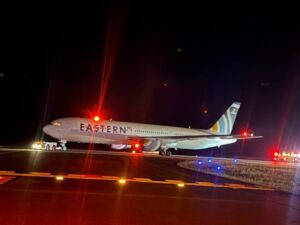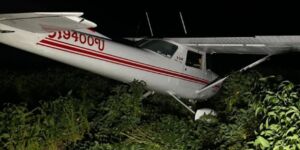These are the stories for today...
Be safe out there!
Tom
'Unbelievable': 'Emergency landing' briefly closes Tallahassee airport, flight diverted
Elena Barrera
An "emergency landing" of a charter flight of armed services members Monday evening at Tallahassee International Airport briefly closed the airport's runway and led to the diversion of one flight back to a Texas airport.
armed services members Monday evening at Tallahassee International Airport briefly closed the airport's runway and led to the diversion of one flight back to a Texas airport.
Passengers on a flight headed to Florida's capital were stuck scrambling for a hotel or spending the night on the floor or in stiff chairs at the Dallas Forth Worth International Airport after being unable to land in Tallahassee.
Just minutes before landing, which was supposed to be around 10 p.m. on Aug. 11, the Tallahassee-bound plane was informed both runways were closed for landing and it had to turn around, said John Matthews, a passenger. The pilot came on over the intercom and said, "Ladies and gentlemen, the Tallahassee airport is closed."
The plane was forced to make the three-and-a-half hour trip back to the Texas airport, getting in around midnight, Matthews said: "It's been unbelievable."
With no official notice from airport officials on social media or otherwise, reports of fire trucks and paramedics on the runways were bouncing around social media. One person posted that the incident was because a chartered flight full of military personnel returning from a month-long stint in California had a mishap during landing.
Tallahassee's Deputy Director of Aviation Vanessa Spaulding confirmed that account in an interview with the Tallahassee Democrat. Spaulding said the charter flight's final destination was intended to be Tallahassee, but around 9 p.m., the pilots – who were transporting National Guard members – called in requesting "an emergency landing" due to the plane experiencing hydraulic issues.
She said the airport immediately coordinated and communicated very closely with its airline partners. From there the airline is supposed to communicate with its passengers.
"This is what we do, we handle things like this and diversions on the daily," she said. "We're trained for this; our team executed the training exceptionally ... I think our team did an exceptional job. It was an overwhelmingly positive response from our team."
Passengers, however, said they were in the dark.
When they landed in Texas, Matthews said that the airline blamed the Tallahassee International Airport for the mix-up and wouldn't provide them with vouchers for food or lodging, so they had to pay out of pocket.
"The hotel here in the airport is $400 a night, so I said to heck with that and took an Uber to a Motel 6," Matthews said.
Matthews said he thinks the Tallahassee International Airport has "some explaining to do" because "nobody seemed to know what was going on."
Passengers later learned that one runway was shut down due to construction and the second was closed because the disabled plane was stuck on the tarmac.
As of 10:40 a.m. Tuesday, nearly 80 people were still waiting in Texas to return to Tallahassee after a long sleepless night. Matthews said they were given little information about what happened and after they landed the pilots and flight attendants walked off without a word.
The runway was cleared in roughly an hour and a half, Spalding said, and no one was injured. "While it was unfortunate and inconvenient for the passengers, the good news is that the plane landed 181 passengers and crew safely, and we're very, very proud of our team's response."
The FAA is investigating the incident that occurred on a plane belonging to Eastern Airlines, a carrier that ceased operations in 1991 but later was reborn to focus on charter and cargo services.
The passenger on social media wrote that the charter plane made a "harder-than-usual landing" and that they "almost ran out of runway and ran into the perpendicular runway for other planes."
He said the plane sat on the runway for over two hours and no explanation was given until an hour in when the pilots informed them that the tires were to hot to move and had to cool down. "Long night, but everyone is OK," he wrote.
Before details of the "emergency landing" became clear, the lack of notice drew fire from Red Tape Florida, a website run by former Tallahassee Democrat publisher Skip Foster, who now heads Hammerhead Communications, a public relations firm.
The blog site, which does not reveal its clients, has been a consistent critic of the airport in its mission of "shining a light on the good, bad and ugly" of bureaucracy in Florida.
"You might think an airport with 58 full-time employees and a $19 million budget would be able to tell the public what was going on," the Red Tape Florida article says. "You would be wrong."
Crews investigating plane crash in Fordsville
By Aaron Weeks
FORDSVILLE, Ky. (WFIE) - Fordsville Fire Department officials are investigating a plane that crashed on Tuesday night.
Department officials are investigating a plane that crashed on Tuesday night.
According to fire crews, the plane went down off Hardinsburg Road.
They say the plane lost an engine and made a safe and controlled landing.
Fire officials say everyone is safe.
https://www.14news.com/2025/08/13/crews-investigating-plane-crash-fordsville/
NTSB Prelim: Kolb Firestar
There Were No Witnesses, And The Exact Time Of The Accident Is Unknown
Location: Meadow Grove, NE Accident Number: CEN25FA261
Date & Time: July 19, 2025, 20:50 Local Registration: N55161
Aircraft: Kolb Firestar Injuries: 1 Fatal
Flight Conducted Under: Part 91: General aviation - Personal
On July 19, 2025, about 2050 central daylight time, a Kolb Firestar airplane, N55161, was destroyed when it was involved in an accident near Meadow Grove, Nebraska. The pilot was fatally injured. The airplane was operated as a Title 14 Code of Federal Regulations Part 91 personal flight.
A family member reported that the pilot departed his private airstrip about 1610. Local authorities were notified of the accident about 2050 when a property owner noticed the airplane in his soybean field. There were no witnesses, and the exact time of the accident is unknown.
The accident site was located in a soybean field about 0.3 mile south of the departure airstrip. Initial ground impact was about 50 ft from the wreckage, and the impact path was oriented on a southwest heading. The forward portion of the fuselage was crushed aft, and the cockpit area was compromised. The left wing was separated at the root and retained by the wing strut.
The right wing remained attached to the fuselage at the root with the wing strut intact. The tailboom was fractured about 2 ft aft of the fuselage consistent with impact forces. It was retained by the elevator and rudder cables. The empennage remained attached to the tail boom. The upper portion of the vertical stabilizer and rudder were deformed consistent with
the impact sequence.
Aileron control continuity was continuous from the control stick to the wing roots, and from the wing roots to the ailerons. Aileron control rod end separations at the wing roots appeared consistent with overstress failures resulting from the impact. The torque tube from the control stick to the aft fuselage was deformed consistent with the impact damage. Both ailerons remained attached to the wings at the hinges. Control cable continuity from the control stick to the elevators and from the rudder pedals to the rudder horn was confirmed.
At the time of the on-scene examination, the engine was separated and rested adjacent to the fuselage. The engine assembly appeared intact. Both intake air filters and carburetors were separated. The left carburetor was located in the debris path. The right carburetor was retained by the fuel inlet hose. Internal engine and gearbox continuity were confirmed via rotation of the crankshaft. Two propeller blades remained attached to the hub and appeared intact. One propeller blade was separated at the root and located in the debris path. The separated blade was deformed and delaminated consistent with ground impact.
The engine ignition modules and engine monitor were retained for further evaluation.
FMI: www.ntsb.gov

Today in History
52 Years ago today: On 13 August 1973 Aviaco flight 118, a Caravelle 10R, crashed while on approach to La Coruña Airport, Spain, killing all 85 occupants.
| Date: | Monday 13 August 1973 |
| Time: | 11:40 |
| Type: | Sud Aviation SE-210 Caravelle 10R |
| Owner/operator: | Aviaco |
| Registration: | EC-BIC |
| MSN: | 225 |
| Year of manufacture: | 1967 |
| Total airframe hrs: | 13118 hours |
| Cycles: | 9380 flights |
| Engine model: | P&W JT8D-7 |
| Fatalities: | Fatalities: 85 / Occupants: 85 |
| Other fatalities: | 0 |
| Aircraft damage: | Destroyed, written off |
| Category: | Accident |
| Location: | 3 km NE of La Coruña Airport (LCG) - Spain |
| Phase: | Approach |
| Nature: | Passenger - Scheduled |
| Departure airport: | Madrid-Barajas Airport (MAD/LEMD) |
| Destination airport: | La Coruña Airport (LCG/LECO) |
| Confidence Rating: | Accident investigation report completed and information captured |
Narrative:
Aviaco flight 118, a Caravelle 10R, crashed while on approach to La Coruña Airport, Spain, killing all 85 occupants.
The Caravelle aircraft took off from Madrid-Barajas Airport at 08:30 GMT and proceeded normally to La Coruña Airport. At 09:14 radio contact was made with La Coruña tower and the flight crew reported 3 minutes away. The tower controller informed the flight that weather at the airport was below minima and that improvement would be slow. The flight crew then decided to hold over Lima Romeo Alpha and said they would report when holding.
Shortly thereafter they informed the tower that they would make an approach down to minima to get a more precise idea of the weather and would hold thereafter. The controller switched on the VASIS and at 09:21 informed the flight that visibility was around 350 m, although he could not see the VASIS at the threshold of runway 22. The flight then reported at 3000 feet beginning the approach. At 09:23 the controller reported a visibility of 600 m. At 09:24 the pilot said he would attempt to land, that he was 2200 feet on approach and had not yet entered clouds. At 09:28 ATC reported 800 m visibility, but that a light breeze was coming up and fog was again closing in from the sea. The crew reported to the tower that they had descended to minima. Since the ground could not be seen, they would therefore begin to hold. At 09:32 the flight crew reported holding at 6000 feet and requested to be informed of any change that might take place.
At 09:34 the controller reported a visibility of 400 m, that the VASIS was still visible. The flight crew then tried to make another attempt to land. At 09:36 the flight crew reported passing the LRA VOR on approach. The controller answered that the lights of the VASIS were no longer visible and that some fog had collected over the runway threshold. The pilot then decided to resume holding.
Weather gradually improved and at 10:20 ATC reported a horizontal visibility of 1500 m and a vertical visibility of 150 m which improved to 250-300 m within three minutes. The pilot acknowledged and said he was leaving 5000 feet for approach. At 10:31 the flight reported passing LRA. At 10:32 the flight reported discontinuing the approach and 6 minutes later the pilot said he was initiating another approach and would report over LRA. At 10:39 the pilot reported over LRA again. Shortly afterward the Caravelle contacted eucalyptus trees, struck the ground, and collided with houses. A fire erupted.
PROBABLE CAUSE: "Pilot violation of the regulations and instructions governing flight over national territory, and the international standards in force in Spain."
